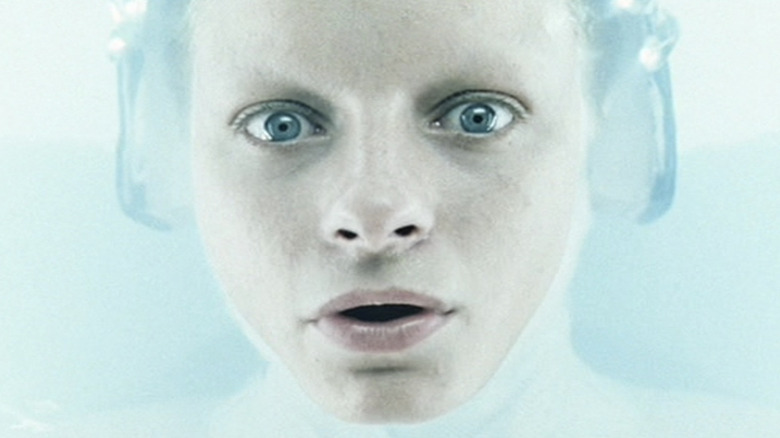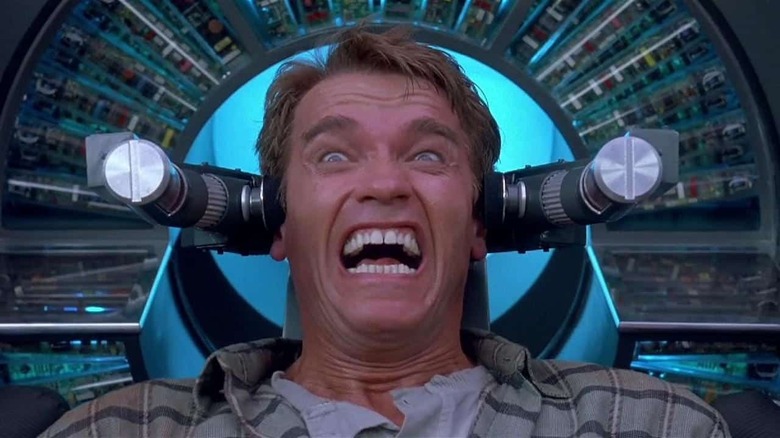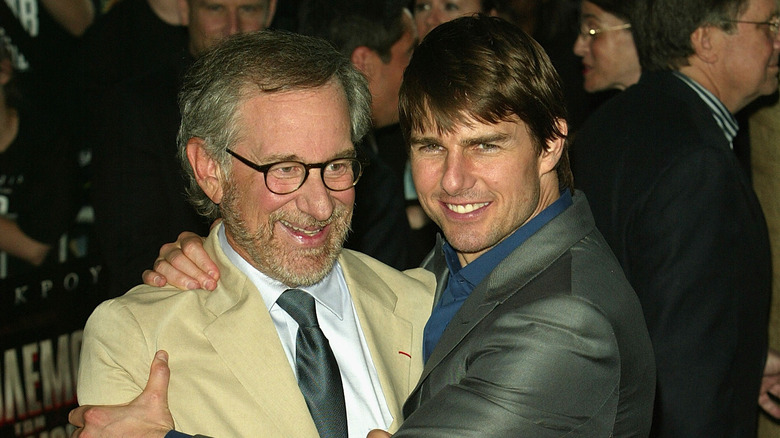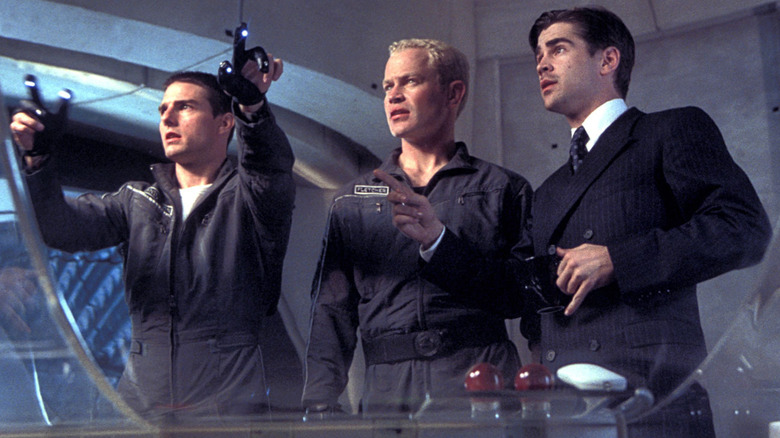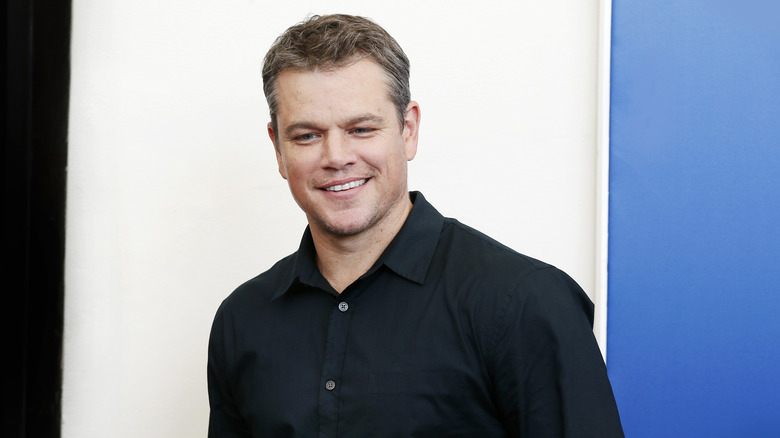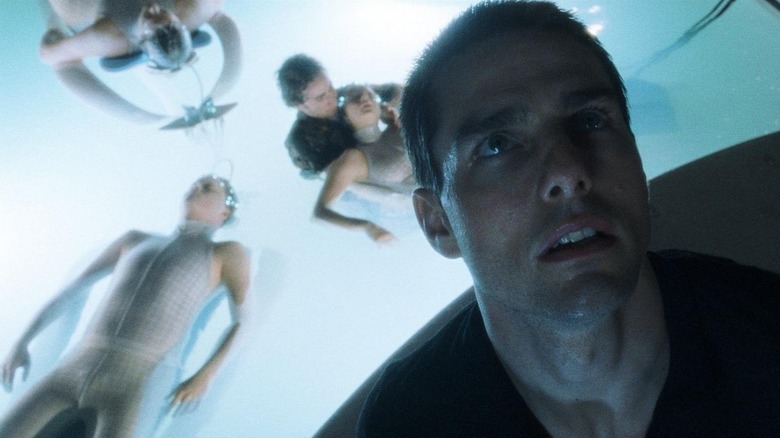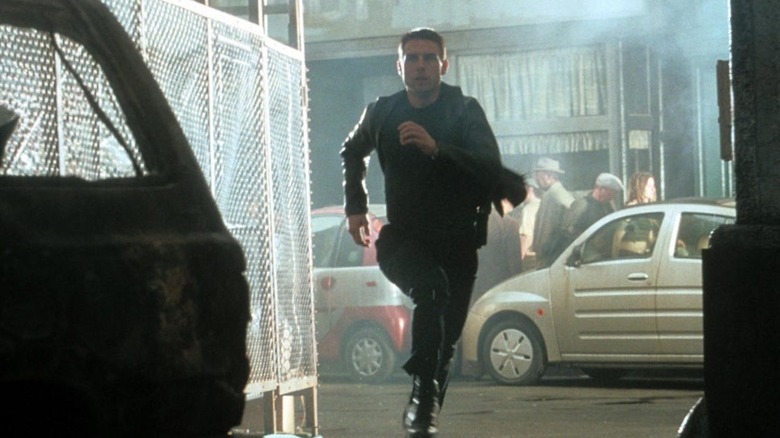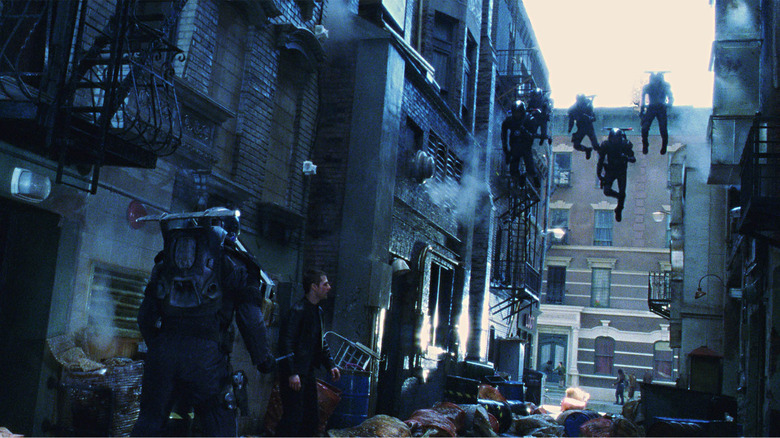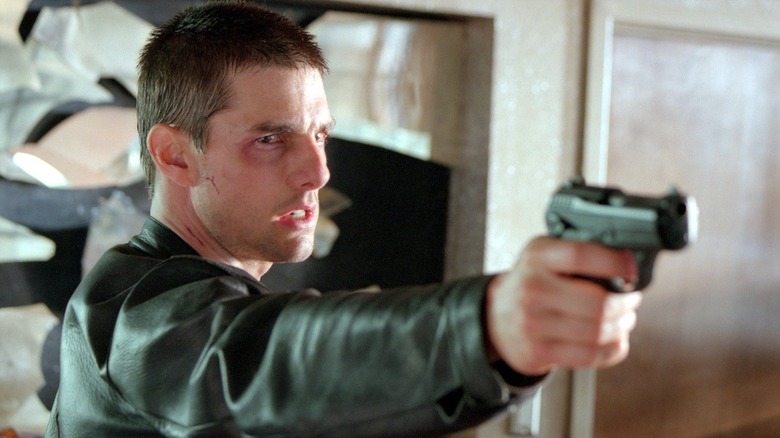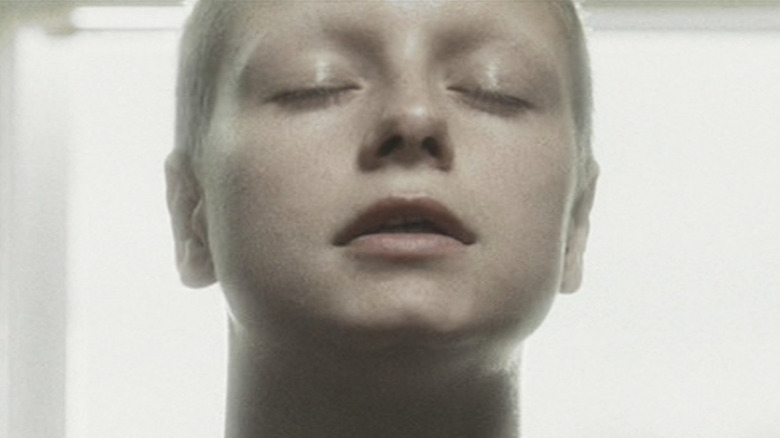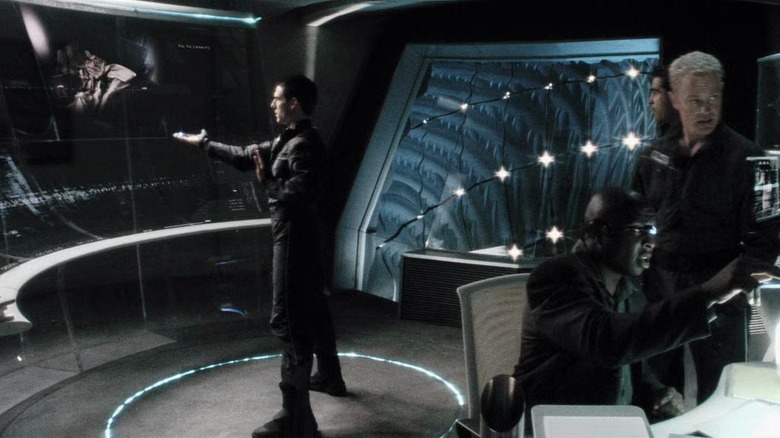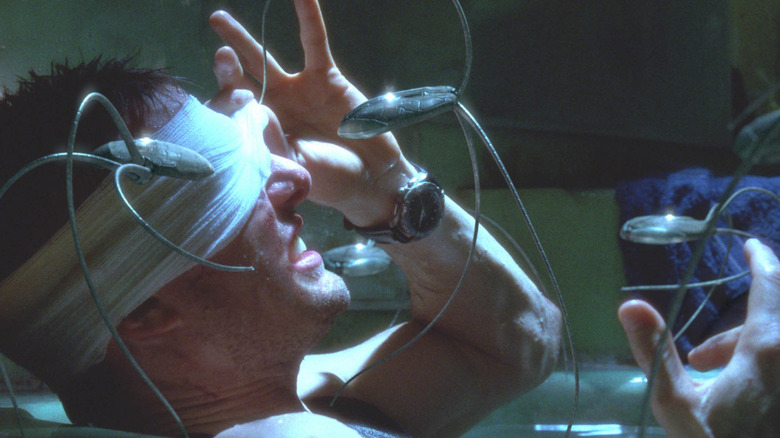The Untold Truth Of Minority Report
In 2002, Steven Spielberg and Tom Cruise joined forces for the first time for the blockbuster "Minority Report." This tale of a future America where crime is prevented before it even happens is a harrowing piece of cinema, and it's one that's thrilling but also has genuine weight to its depiction of a man on the run. There are grave consequences to everyone's actions, which only makes the story extra immersive. Coming out in the early 2000s alongside other darker Spielberg fare like "A.I.: Artificial Intelligence" and "Munich," "Minority Report" is a fascinating entry into one of the boldest eras of this director's filmography. Despite making quite a bit of money at the box office, though, there's plenty about "Minority Report" that most people simply don't know.
The history of "Minority Report" is wide-ranging and covers everything from how long Cruise and Spielberg had been planning to work together to the specific vision Spielberg had for this futuristic society to what movie "Minority Report" was originally supposed to be a sequel to. Much like with the tiniest details in a vision offered up by the future-seeing precogs, there's a lot to unpack in the untold truth of one of Spielberg's grimmest and most propulsive blockbusters.
Minority Report was once set to be a Total Recall sequel
Years before Steven Spielberg and Tom Cruise brought "Minority Report" to the big screen, audiences almost saw a radically different version of this project. Per Gizmodo, Philip K. Dick's short story "Minority Report" was optioned in the 1990s for a feature film that would be helmed by "Total Recall" director Paul Verhoeven. When looking over the story, Verhoeven felt it would be perfect material for a sequel to his 1990 film "Total Recall." The connection between these two sci-fi properties wasn't totally random, as "Total Recall" was based on another Phillip K. Dick story, "We Can Remember It For You Wholesale."
From there, the follow-up began to move quickly into production, with "Total Recall" leading man Arnold Schwarzenegger agreeing to come back for the sequel. However, just as the project was getting off the ground, Carolco — the production company in charge of the feature — went bankrupt. The script then got snagged by 20th Century Fox, who decided to make a stand-alone "Minority Report" movie that didn't have any connection to "Total Recall." This eventually lead to Spielberg's take on "Minority Report," which was co-produced by 20th Century Fox. While the final version of "Minority Report" garnered widespread acclaim, fans of "Total Recall" are doubtlessly disappointed they never got a sequel to this film.
Why Steven Spielberg was attracted to Minority Report
There was a lot that might make "Minority Report" an attractive project for director Steven Spielberg. For one thing, it was a production that would unite the filmmaker with Tom Cruise, an actor he'd not yet had the chance to work with. For another, it was a science-fiction film, a genre Spielberg had extensive experience with, dating back to his work on "Close Encounters of the Third Kind" in 1978. Finally, the plot concerned a broken family, a recurring fascination for Spielberg in his films in everything from "E.T.: The Extra-Terrestrial" to "Empire of the Sun."
However, what specifically attracted Spielberg to the world of "Minority Report" was how it was largely something he'd never done before. Talking to Seattle PI, Spielberg noted that he'd never made a mystery movie like "Minority Report," which was steeped in the kind of uncertainty and griminess that defined so many vintage noirs he loved. He explained, "I had never structured a mystery before. ... I went back to (the ones) I remembered loving, like 'The Man Who Knew Too Much,' 'North By Northwest,' 'The Maltese Falcon' and 'Key Largo.' I had a field day looking at, you know, what's the protoplasm that makes those mysteries work." Within these exciting new confines, Spielberg was able to tap into some familiar storytelling elements, but it was the unprecedented aspects of "Minority Report" that truly excited him as an artist.
Tom Cruise and Steven Spielberg's long desire for collaboration
"Minority Report" wasn't just another Tom Cruise action movie nor was it just another sci-fi film helmed by Steven Spielberg. This was a momentous moment in the career of both of these men, as it finally gave Cruise and Spielberg a chance to work with each other. It was no coincidence that the duo was finally making a movie together on "Minority Report," either, as they had been trying to unite forces for years.
Speaking to Entertainment Weekly, Spielberg recalled how he had first met Cruise on the set of "Risky Business" back in the early 1980s. Right then and there, a spark began to form between the two and they were determined to work together. Cruise put it plainly: "I just knew I wanted to work with the guy. Even back then he was Steven Spielberg. The guy who did 'E.T.' and 'Raiders of the Lost Ark.”' Years went by, however, as they kept trying to figure out the perfect project to join forces on.
Things almost came together for them when Spielberg was set to direct Cruise on 1988's "Rain Man." However, Spielberg had to depart the film because of scheduling conflicts with "Indiana Jones and the Last Crusade," but he never gave up on his ambitions of directing a Tom Cruise star vehicle. Eventually, Cruise brought "Minority Report" to Spielberg, and suddenly, these years of yearning came to fruition. Finally, here was a production that united an iconic director with an equally iconic actor.
Minority Report was supposed to be made before A.I.
At the dawn of the 21st-century, speculation was running rampant over what would be the next Steven Spielberg directorial effort. The filmmaker's last film had been the 1998 feature "Saving Private Ryan," which scored Spielberg his second Best Director Oscar win and was one of the highest-grossing films of the year (via Box Office Mojo). These feats, combined with the man's reputation as one of the most acclaimed and successful directors ever, meant that all eyes were on where he would go next. "Minority Report" initially looked like a potentially ripe candidate to be the first Spielberg movie of the 2000s, especially once he turned down the opportunity to direct "Harry Potter and the Sorcerer's Stone" (via The Guardian).
Plans to have "Minority Report" film in the first year of the 21st-century were scuttled in March 2000 when it was announced that Spielberg would be helming "A.I.: Artificial Intelligence" first (via BBC News). "A.I" was a production that had been lingering on Spielberg's "to-do list" for years, but it took precedent once Stanley Kubrick, who wrote the screenplay for "A.I.," passed away in March 1999. Kubrick had spent decades writing "A.I." and this, combined with the deep bond he and Spielberg shared, inspired Spielberg to make this film a priority. So, the start date of "Minority Report" got pushed to April 2001, which meant it would not have the honor of being Spielberg's first directorial effort of the new century.
Matt Damon was supposed to be in Minority Report
While Tom Cruise was always set to anchor the world of "Minority Report" as the protagonist John Anderton, several other actors came and went from the film's supporting cast over the course of its production. Many of these were massive names, who could've been right at home with the level of prestige associated with Cruise and Steven Spielberg. One such person was Matt Damon, who was approached to play a character who has a kinship with John, but then is forced to hunt him down when John is pre-accused of murder.
Per USA Today, Damon was interested in the part, and his then-recent Oscar win for writing "Good Will Hunting" would have made him an appropriately acclaimed artist for such a star-studded project. Plus, Damon and Spielberg had already worked together once before on the box office juggernaut "Saving Private Ryan." While Damon was dying to reunite with this filmmaker, it was never meant to be. Scheduling conflicts prevented him from joining Cruise in "Minority Report." Damon was already on the line to do "Ocean's Eleven" and the filming schedule for that Steven Soderbergh ensemble piece directly conflicted with "Minority Report." With that, "Minority Report" began to look around for someone else to take on the role instead (which eventually went to Colin Farrell).
Minority Report's newfound post-9/11 relevance
"Minority Report" was filmed in the summer of 2001, and wrapped just a few months before the terrorist attacks of September 11 would forever alter the United States of America. In the wake of such devastating horrors, it was inevitable for people to read new 9/11-relevant layers into pieces of art that were never meant to talk about this historical event. When it came to "Minority Report," even director Steven Spielberg recognized how the project would inevitably come across as something that had extra important and timely relevance to moviegoers due to the state of the world after 9/11.
Speaking to The New Zealand Herald, Spielberg was upfront about how a film like "Minority Report" — which is about policing and privacy — would register with people in the wake of 9/11. He noted that the film mirrored how authorities were rounding up people in real life to get information and prevent future atrocities, saying "I feel that history has caught up with our imagination and given us a cold soak of reality." "Minority Report" would only become even more eerily relevant in the years to come, though, as the PATRIOT Act enhanced the surveillance of the American government on its citizens, while controversy over torture tactics on innocent civilians would make people question the lengths the United States had gone in the name of preventing future terrorist attacks.
The noirs that guided Spielberg's Minority Report vision
In many ways, "Minority Report" was a movie that could only exist in the 21st century, namely with its digital-effects wizardry and its use of then-fresh-faced talent like Colin Farrell and Samantha Morton. But it's also a feature rooted deeply in one of the great film genres of the 20th century: noir. Film noir — which literally means "black film" — often focuses on stories of lone protagonists, who must endure in the face of societies gone haywire due to moral corruption. So, it's easy to see why "Minority Report" would fit into the hallmarks of this genre.
But to ensure that "Minority Report" lived up to all of its potential, Spielberg opted to do a crash course in the all-time greats of the noir landscape before he started shooting this Tom Cruise vehicle. Talking to Entertainment Weekly, Spielberg said that he "wanted to give the movie a noir feel," and subsequently threw himself a film festival of classics of the genre: "Asphalt Jungle," "Key Largo," and "The Maltese Falcon" were the movies he turned to while molding his vision for "Minority Report." He also noted that he tried to embrace the darker edges of the genre in order to counter his "sentimental side."
How Spielberg approached technology within Minority Report
Much like our own modern world, the universe that "Minority Report" inhabits is one defined by technology. Not only is futuristic tech used to prevent crimes before they even happen, but virtual ads show up all over the place, while spider robots are used to hunt down lethal criminals. This is a world defined by machines even more than by the men that made them. Because of their importance to the story, Steven Spielberg was very careful about the role technology would play in "Minority Report" and how it would be realized.
According to Entertainment Weekly, Spielberg gathered a group of futurists and asked them to brainstorm about a plausible vision of what life in 2054 could be like. Talking to Roger Ebert, Spielberg elaborated that his goal with "Minority Report" was to make a movie where all the futuristic tech shown on-screen could eventually become a reality. This informed some hopeful details about "Minority Report's" vision of what's to come, including the idea of a transportation system that isn't as harmful to the environment. Simultaneously, he wanted to present an eerie quality to the intrusive nature of futuristic advertising.
Spielberg believed that "in the future, television will be watching us, and customizing itself to what it knows about us." He continued, "The thrilling thing is, that will make us feel we're part of the medium. The scary thing us, we'll lose our right to privacy." This dichotomy gets reflected in various spots in "Minority Report," which both demonstrates how far media and consumer materials have come, and also how nobody has privacy in this society on-screen. This approach to technology informed the urgent darkness of "Minority Report," but also proved prescient (or precognitive, if you will) in how the digital world would evolve in the decades to come.
Spielberg's insistence on practical sets
In the summer of 2002, both George Lucas and Steven Spielberg released new directorial efforts that were costly action blockbusters. Lucas debuted "Star Wars: Attack of the Clones," which heavily utilized digital sets. In contrast, Spielberg's "Minority Report" primarily employed practically realized backgrounds. Even though this mystery takes place in the future, Spielberg still went the route of building elaborate sets that the actors could see and feel as they shot the film. Though they had both come into their own as iconic filmmakers in the 1970s, the summer of 2002 made it clear that Lucas and Spielberg had drastically different aims now in terms of visual sensibilities and approaches.
Talking to Roger Ebert, Spielberg expressed admiration for "Attack of the Clones" and all that Lucas had accomplished with his digital sets. However, Spielberg also said that he was hoping to never get to the point where he was shooting movies that would involve just green screens and CGI sets, in part because physical sets stimulate and inspire the actors.
On "Minority Report," Spielberg was insistent that practical sets be used whenever possible, while even the most seemingly impossible pieces of camerawork — such as the overhead shot of the robotic spiders entering the building where John is hiding — were realized through on-set ingenuity rather than post-production digital wizardry. Spielberg's commitment to old-school production design choices ensured that the world of "Minority Report" reverberated with tangibility and grit.
Samantha Morton's experience working with Spielberg
In reflecting on Steven Spielberg to OC Movie Reviews in January 2022, "Minority Report" actor Samantha Morton, who portrays the precog Agatha, had a startling declaration to make about this filmmaker: He's good at his craft. Referring to him as "an incredible filmmaker," Morton especially appreciates "Schindler's List." This 1993 Oscar-winning film struck Morton as the kind of feature that's brutal to watch, but also important to remind the world of atrocities that "should never happen again."
Morton's admiration for Spielberg goes deeper than just what he accomplishes as an artist, though. She also noted that he is "an absolutely amazing person to work for." Remarking that because she was "quite young" when she did "Minority Report," her experience working with Spielberg established a great threshold and "set the bar very high" for the remainder of her career.
Even better, Morton's fondness for Spielberg only deepened when she did the 2022 film "Save the Cinema," an inspirational drama about a small town trying to save a movie theater. The film is based on a true story about the mayor of the Welsh town Carmarthen sending a letter to Steven Spielberg in 1993, imploring the director to make it possible for "Jurassic Park" to be screened in Carmarthen (via Wales Online). Amazingly, Spielberg responded and the film premiered in this small town the same day as in London. Realizing what Spielberg had done to help everyday people in real life only emphasized how much Morton adored her former "Minority Report" director.
The distinctive cinematography of Minority Report
Perhaps more distinct than any of the fight scenes or explosions in "Minority Report" is the look of the entire feature. The visual style of "Minority Report" is unique and feels drained of color, which complements the grim atmosphere of the film. Talking to The New York Times, Steven Spielberg noted that he used a process called bleach-bypassing to achieve this effect. Bleach-bypassing is done in post-production, and drains out the color from people's faces. Now instead of having cheeks and skin tone that radiate warmth, everyone in "Minority Report" has pale faces, which helps to accentuate their constantly intense and paranoid demeanors.
Spielberg noted that touches like this brought "to the photo-realism a kind of abstract expressionism," while several sequences were shot on 800 ASA film stock to further ensure an old-school grainy appearance that would make "it feel more like old noir." The end result was that "Minority Report" combined older-looking techniques and styles seen predominately in the 1940s with a modern tale and technology, which truly made it look like no other movie out there. This was especially the case among the big-budget blockbusters made at the dawn of the 21st-century, which tended towards more modern and digital looks.
The box office run of Minority Report
"Minority Report" arrived in theaters with lots of hype, thanks to its between Tom Cruise and director Steven Spielberg. The melding of these Hollywood titans excited film fans, but there was also some concern wafting in the air around its release. Chiefly, this was an unusual blockbuster in the summer of 2002. This was a season dominated by lighthearted "Star Wars" adventures and the first "Spider-Man" movie (via Box Office Mojo). These movies were a sharp contrast to the more grounded and darker noir-inspired tale that "Minority Report" was delivering. Spielberg and Cruise were also coming off titles that were widely perceived to be box office missteps ("A.I." and "Vanilla Sky," respectively), a sign that even immortal legends could stumble financially.
In the end, "Minority Report" did manage to secure $358.8 million worldwide, more than tripling its sizable $102 million budget. This feature also came in ahead of other notable Spielberg titles globally, such as "Indiana Jones and the Temple of Doom" and "Close Encounters of the Third Kind." If there was a complaint to be had here, it's that "Minority Report" did get overshadowed by several other 2002 movies. While it was the 10th biggest film of the year worldwide, domestically, "Minority Report" was in 17th place. It even came in behind titles like "Signs" and "xXx," neither of which promised the union of Cruise and Spielberg. While it didn't crush all other 2002 movies, "Minority Report" was still a profitable exercise, reinforcing that Spielberg blockbusters can always draw a mighty crowd.
